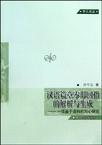汉语篇章零形回指的解析与生成
1970-1
上海译文出版社
许宁云
348
《汉语篇章零形回指的解析与生成》的特色是将当前国外先进的计算语言学理论“向心理论”有效应用于汉语篇章零形回指的解析与生成,提出的模型和算法经过实际语料的验证可有效解析和生成汉语篇章零形回指,它对于对外汉语教学中回指的确认和理解具有一定的启发和辅助作用,尤其对于包括机器翻译、自动文本概要和信息提取在内的自然语言处理具有一定的应用价值。篇章零形回指的解析与生成是汉语篇章处理的关键环节,也是当前篇章处理研究的热点之一,而就目前的国内外研究现状来看,绝大部分研究都缺乏明晰的表征手段和形式化操作模式。
前言ABBREVIATIONSTABLES AND FIGURESChapter 1 INTRODUCTION1.1 What is anaphora?1.2 Types of anaphora1.3 Anaphora resolution and generation1.4 Scope and goal of the study1.5 Organization of the studyChapter 2 PREVIOUS APPROACHES TO ZERO ANAPHORA IN CHINESE2.1 Introduction2.2 A syntactic approach2.3 An extra-syntactic approach2.3.1 The discourse framework2.3.1.1 Li and Thompson‘s conjoinabihty constraint2.3.1.2 Chen’s predictability condition and neg- ligibility condition2.3.1.3 Zhou‘s global coreference2.3.1.4 Xu’s functional approach2.3.1.5 Tao‘s emergent reference2.3.1.6 Cheng and Lee’s recovery principles2.3.1.7 You‘s recovery rules2.3.1.8 Xu’s resolution principle2.3.2 Huang‘s pragmatic approach2.3.3 Tomlin and Pu’s cognitive approach2.4 SummaryChapter 3 CENTERING THEORY3.1 Introduction3.2 Centering theory3.2.1 General description3.2.2 Coherence and attentional state3.2.3 Coherence and referring expression form3.2.4 Centering definitions and constraints3.3 SummaryChapter 4 RESOLVING CHINESE ZERO ANA- PHORS WITH RICM4.1 Introduction4.2 BFP algorithm for centering and anaphora resolution4.3 Implementation of BFP4.4 Problems with Centering and BFP4.5 Previous proposals for possible solution4.5.1 The Stack Model4.5.2 The Global Model4.5.3 The Cache Model4.5.3.1 Basic notions of the Cache Model4.5.3.2 Integrating cache model with centering algorithm4.5.3.3 Implementation of ICM4.5.3.4 Evaluation of ICM4.6 A Revised Cache Model4.6.1 Introduction4.6.2 Theoretical assumptions4.6.3 Revision of Centering Rule 1(Pronoun Rule)4.6.4 Integrating the revised cache model with centering algorithm4.6.5 Implementation of RICM4.6.6 A simplified version of RICM4.6.7 Evaluation of RICM4.6.8 Experiment4.6.8.1 Data4.6.8.2 Procedure4.6.8.3 Result4.6.8.4 Discussion4.7 SummaryChapter 5 SETTING PARAMETERS FOR CEN- TERING ANALYSIS ON CHINESE DISCOURSE5.1 Introduction5.2 Specifying the utterance unit5.2.1 Introduction5.2.2 What is an utterance?5.2.3 Utterance for Centering analysis5.2.4 Intermediate summary5.3 Discourse segmentation5.3.1 The difficulty with discourse segmentation5.3.2 Problems arising from different segmentations5.3.3 Specifying discourse segment for Chinese5.3.3.1 Topic chain as discourse segment5.3.3.2 Topic continuity as discourse segment5.4 Ranking forward-looking centers in Chinese5.4.1 Related cross-linguistic work5.4.2 Topic as a grammatical concept5.4.3 Topic and reference5.4.4 The ranking hierarchy5.4.5 Other factors contributing to the salience of entities5.4.6 Ranking complex NPs5.5 SummaryChapter 6 GENERATING CHINESE ZERO ANAPHORS6.1 Introduction6.2 Previous Centering approaches to generating (zero) anaphors6.3 Assumptions6.4 Corpus study6.4.1 Corpus and coding6.4.2 Results and analysis6.5 Developing zero generation algorithm6.5.1 Zero generation algorithm(I)6.5.2 The privilege of transition pairs6.5.3 Zero generation algorithm(l)6.5.4 Zero generation algorithm(m)6.6 SummaryChapter 7 COMPUTATION OF TRANSITION TYPES7.1 Introduction7.2 Transitions for modeling coherence7.3 The problem of inferable centers7.4 Inferable centers as bridging references7.5 Possible solutions to inferable centers7.5.1 Laurel Fals‘s proposal7.5.2 Extension of LFP7.5.2.1 Overestimation of complete shifts7.5.2.2 The “Cheapness” Principle by SHP7.5.2.3 Integrating LFP with SHP7.6 SummaryChapter 8 CONCLUSION8.1 Major findings8.2 Limitations8.3 Directions for future studyREFERENCES
